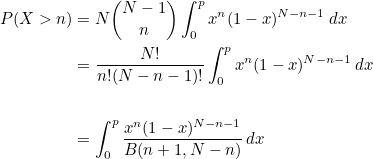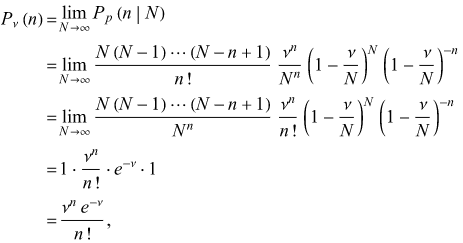Statistics [03]: Some Common Discrete Distributions
Published:
This post will summarize some of the commonly used discrete distributions, including
- Uniform distribution
- Bernoulli distribution
- Binomial distribution
- Geometric distribution
- Negative binomial distribution
- Poisson distribution
- Hypergeometric distribution
- Mulitnomial distribution.
Uniform Distribution
The discrete uniform distribution is also known as the “equally likely outcomes” distribution. Letting a set have
elements, each of them having the same probability. Then, the probability distribution function and cumulative distributions function are respectively
Bernoulli Distribution
The Bernoulli distribution is a discrete distribution having two possible outcomes labelled by and
in which
occurs with probability
and
occurs with probability
. Therefore, it has probability density function

which can also be written as
The cumulative distribution function is

The performance of a fixed number of trials with fixed probability of success on each trial is known as a Bernoulli trial.
The distribution of heads and tails in coin tossing is an example of a Bernoulli distribution with . The probability of A winning each game in the example give in this post is an example of Bernoulli distribution with
.
The Bernoulli distribution is the simplest discrete distribution, and it the building block for other more complicated discrete distributions.
Binomial Distribution
The binomial distribution gives the discrete probability distribution of obtaining exactly
successes out of
Bernoulli trials. The binomial distribution is therefore given by
Given the binomial distribution, the probability of obtaining more successes than the observed in a binomial distribution is
where
is the beta function, and
is the incomplete beta function, with
and
To prove the above relationship, first differentiate both sides wrt .

Then integrate, we get

Geometric Distribution
The geometric distribution gives the discrete probability distribution of obtaining exactly
failures of Bernoulli trials before first success. The geometric distribution is therefore given by
The cumulative distribution function is
The geometric distribution is memoryless. It is a discrete analog of the exponential distribution.
Negative Binomial Distribution
The negative binomial distribution is a combination of binomial distribution and geometric distribution, which gives the probability of successes and
failures in
trials, and success on the
trial. The probability density function is therefore given by
The cumulative distribution function is (Proof?)
The negative binomial distribution gets its name from the following relationship (Proof):
With this relationship, we have
Poisson Distribution
Possion distribution is often used to describe comparatively rare cases, and when the becomes very large in binomial distribution, possion distribution can be a good approximation.
Viewing the binomial distribution as a function of the expected number of successes
instead of the sample size for fixed
. Then, the equation for binomial distribution becomes
Letting the sample size N become large, the distribution then approaches

which is known as the Poisson distribution.
Hypergeometric Distribution
Let there be ways for a “good” selection and
ways for a “bad” selection out of a total of
possibilities. Take
samples and let
equal 1 if selection
is successful and 0 if it is not. Let
be the total number of successful selections,
The probability of successful selections is
Multinomial Distribution
Let a set of random variates have a probability function
and are constants with
and
Then the joint distribution of is a multinomial distribution and
is given by the corresponding coefficient of the multinomial series
Table of Contents
- Probability vs Statistics
- Shakespear’s New Poem
- Some Common Discrete Distributions
- Some Common Continuous Distributions
- Statistical Quantities
- Order Statistics
- Multivariate Normal Distributions
- Conditional Distributions and Expectation
- Problem Set [01] - Probabilities
- Parameter Point Estimation
- Evaluation of Point Estimation
- Parameter Interval Estimation
- Problem Set [02] - Parameter Estimation
- Parameter Hypothesis Test
- t Test
- Chi-Squared Test
- Analysis of Variance
- Summary of Statistical Tests
- Python [01] - Data Representation
- Python [02] - t Test & F Test
- Python [03] - Chi-Squared Test
- Experimental Design
- Monte Carlo
- Variance Reducing Techniques
- From Uniform to General Distributions
- Problem Set [03] - Monte Carlo
- Unitary Regression Model
- Multiple Regression Model
- Factor and Principle Component Analysis
- Clustering Analysis
- Summary

Comments